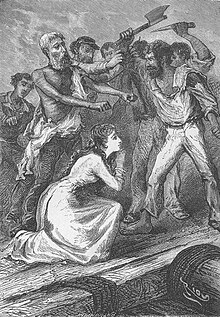The Chancellor

The Chancellor (also the diary of the passenger JR Kazallon , The Last Voyage of the Chancellor , Catastrophe in the Atlantic , Explosives in the Ship or The Shipwreck of the Chancellor ) is a novel by the French author Jules Verne , which was first published in 1875 by the publisher Pierre-Jules Hetzel under the French title Le Chancellor was published together with the short story Martin Paz . The German-language edition appeared in 1875 under the title Die Chancellor . The book was published in Germany under the title The Last Voyage of the Chancellor , Diary of Passenger RJ Kazallon or Disaster in the Atlantic . It is one of Jules Verne's most unusual works.
action
The passenger JR Kazallon, who wants to travel from the USA to Europe in 1869, embarks on the three-master Chancellor , which is to sail under Captain Huntly across the Atlantic from Charleston (South Carolina) to Liverpool . He describes the course of the trip in his diary. The sailing ship transports cotton, and there are also some passengers on board, as there is no other direct connection from South Carolina to England . The Chancellor passes the Bermuda Islands. On the further journey it turns out that the captain is mentally confused. A wrong course was taken at his command. After a night of unrest, Kazallon learns that a fire has broken out on board because the cotton has caught fire. Since the captain behaves strangely from day to day, command of the ship is taken over by the second officer Kurtis. The situation is further complicated by the fact that a passenger, the merchant John Ruby, without authorization, a co-location with soda - picrate , a high explosive, has brought on board. After a fortnight, the passengers have to be evacuated from their cabins, as the heat in the bilge keeps increasing. The Chancellor sets course for the Lesser Antilles .
An explosion shakes the ship and the fire breaks out openly. Some sailors want to flee with the dinghy on board , but are held back by Kurtis. Ruby jumps into the fire and commits suicide. The Chancellor runs on an unknown reef and leaks. The leak can be patched up in a makeshift manner and the way to continue with the Picrat can be blasted. The fire was extinguished by the ingress of water. But the ship takes more and more water as it continues and sinks deeper and deeper. The sailors begin mutiny, but Kurtis still has the situation under control. Huntly, a passenger and three sailors flee with the dinghy. A raft is being built on which all eighteen survivors still on board embark. The Chancellor is sinking. The food supplies are largely washed overboard in a storm and water supplies are running out. The situation on the raft is getting worse. The crew plans to use cannibalism to get food. The distress can initially be alleviated by catching fish. A mutiny is put down. Sharks circle the raft. A passenger dies. When his body is about to be thrown overboard, Kazallon sees that the body is missing a foot. The captain had apparently used it as bait for the fish while fishing. After all, after eating, you will run out of drinking water. A brig is sighted, but it turns off again. The steward Hobbart commits suicide after Kazallon discovers that he was hiding meat. The sailors devour his corpse. The survivors will choose which of them will be slaughtered next. It hits the physically disabled André Letourneur. However, his father sacrifices himself for him. Before this can be slaughtered, Kazallon discovers that they are driving through fresh water. They are drifting towards the river delta of the Amazon . The remaining eleven survivors are eventually rescued by fishermen from the island of Marajó .
criticism
The author describes the circumstances that lead to the catastrophe, the attempts of the crew to save the ship and the suffering of the survivors who floated across the Atlantic on a raft after the sinking of the Chancellor . The survivors are hungry, they have hallucinations . Some sailors commit suicide by hanging themselves or jumping off the ship and throwing themselves at the sharks circling the raft. Gradually the civilized flakes off the castaways, greed and resentment come to the fore. The crew rebels against the passengers. Only at the very last moment is a “wonderful rescue” prevented from turning the shipwrecked into cannibals.
The author's style is concise and straightforward. Jules Verne dispenses with the instructive insertions and funny scenes that are otherwise common in his work, which would in any case not be appropriate for the subject of the work. The characters are also known from disaster films such as The Poseidon's Infernal Journey or Flaming Inferno , although Jules Verne rather anticipates these works; there is the greedy merchant who causes the catastrophe by bringing explosives on board and, when he learns of the fire, loses his head and causes panic; there is the ignorant captain of the three-master, who is not up to his profession; there is the rich idleness who, in order to save himself, abandons his sick wife and still cannot escape his death; and there is the first officer who always keeps a cool head and saves everyone. The figures are drawn hauntingly and lifelike.
literature
- Heinrich Pleticha (ed.): Jules Verne manual . Deutscher Bücherbund / Bertelsmann, Stuttgart and Munich 1992.
- Volker Dehs and Ralf Junkerjürgen: Jules Verne . Voices and interpretations of his work. Fantastic Library Wetzlar, Wetzlar 2005.
- Volker Dehs: Jules Verne . Jules Verne. A critical biography. Artemis & Winkler, Düsseldorf 2005, ISBN 3-538-07208-6 .
Web links
- "The Chancellor" as an e-book in HTML on zeno.org
- "The Chancellor" as an audio book in MP3 on archive.org
- The Chancellor in Andreas Fehrmann's Jules Verne Collection

